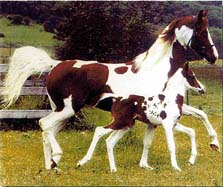Pinto
N/A
Fri, 6th June, 2025 - 8:59 pm GMT
Sponsor Ads:

Alternative Name
N/ABasic Info
One of the most frequently asked question regarding the Pinto is "what is the difference between Pintos and Paints?" Simply put: The Paint Horse (registered by the American Paint Horse Association) is limited to horses of documented and registered Paint, Quarter Horse, or Thoroughbred breeding. The difference in eligibility between the two registries has little to do with color or pattern; only bloodlines. While most Paints can be double registered as Stock or Hunter type Pintos, the Pinto Horse Association (PtHA) also allows for the registration of miniature horses, ponies, and horses derived from other breed crosses, such as Arabian, Morgan, Saddlebred, and Tennessee Walking Horse, to name a few. The color requirements for a registered Pinto is predicated on the age of the animal at time of application. Only four square inches of cumulative white in the qualifying zone is required to register a horse with the PtHA (only three inches for ponies and two square inches for miniatures.) Animals with insufficient "qualifying color" to be accepted in the regular color division but with at least two or more "Pinto" characteristics or solid colored animals with documented and registered pinto-colored sire and/or dam may be eligible for registration in the Breeding Stock Division. There are two recognized Pinto color patterns: Tobiano (Toe-bee-ah'-no) and Overo (O-vair'-o). The Tobiano pattern appears to be white with large spots of color, often overlapping on animals with a greater percentage of color than white. Spots of color typically originate from the head, chest, flank, and buttock, often including the tail. Legs are generally white, giving the appearance of a white horse with large or flowing spots of color. Generally, the white crosses the center of the back or topline of the horse. It is considered necessary to have a Tobiano parent to achieve a Tobiano foal. The Overo pattern appears to be a colored horse with jagged white markings usually originating on the animal's side or belly, spreading toward the neck, tail, legs, and back. The color appears to frame the white spots. Thus, an Overo often has a dark tail, mane, legs, and backline. Bald or white faces often accompany the Overo pattern. Some Overos show white legs along with splashy white markings, seemingly comprised of round, lacy white spots. White almost never crosses the back or topline. A horse of Pinto coloration descendant from two solid colored parents of another typically solid colored pure breed is called a "crop-out" and is of the Overo pattern. While PtHA accepts animals derived from many different approved breed/registry crosses, it does not accept animals with Appaloosa, Draft or Mule breeding and/or characteristics. Horse stallions must have both sire and dam registered with PtHA or another approved outcross registry. Pony/Miniature stallions must have at least one parent (sire or dam) registered with a recognized breed association [Effective 1-1-99]. Mares and Geldings can be registered on their qualifying color alone. PtHA accepts horses in four different height divisions: "Horse" for animals maturing over 56" in height at the withers; "Pony" for animals 56"and under, but over 34"; "Miniature" for animals 34" and under at maturity and "B Miniature" for animals over 34" but not exceeding 38" at maturity
Health
N/AHabitat
N/ABehavior
Use : Riding, ranch. The Pinto was a favorite of the native American Indians. There are four acknowledged types of conformation however: the Saddle type, Stock type, Hunter type and Racing type. Type is determined by the conformation and background of each horse/pony. The STOCK TYPE Pinto is of predominanty Quarter and Paint breeding and conformation. The HUNTER TYPE Pinto is of predominantly Thoroughbred breeding and conformation. The PLEASURE TYPE Pinto is of predominantly Arabian or Morgan breeding and conformation. The SADDLE TYPE Pinto is American Saddlebred, Tennessee Walking or Missouri Foxtrotter breeding and conformation. Saddle Type HORSE: English horse of predominantly Saddle, Hackney or Tennessee Walking Horse breeding displaying high head carriage and animated, high action of these breeds. PONY: English-type pony displaying the carriage, animation, and action of the Saddle and Tennessee Walking Horses and modern style Shetland and Hackney Ponies. Hunter Type HORSE: English horse of predominantly Thoroughbred breeding. PONY: Reflects conformation associated with the Thoroughbred horse and Connemara Pony. Stock Type HORSE: Western horse of predominantly Quarter and Paint Breeding and conformation. PONY: Western type displaying conformation with Quarter Horse and original Shetland Pony. Pleasure Type HORSE: Horse of predominantly Arabian Horse and/or Morgan breeding. PONY: Reflects carriage and conformation associated with the Arabian and Morgan horse and Welsh pony. Each type is shown in its own respective class and breeding is encouraged to be kept within a specific type. The association strives to produce each succeeding generation with improved style and talent within one of these types. As with all breeders, Pinto Breeders believe that conformation is an important factor in what a horse can do for the rider.Origin
AmericaHistory
For its contribution to our predecessors dating back as far as history is recorded, the horse has been immortalized in story and song. A key part of civilization, it is also well represented in art. Studies of this art history reveal the early existence of what we recognize today as the Pinto Horse: a horse whose dual-colored coat pattern is comprised of white areas combined with another of the basic coat colors common to horses, making each Pinto unique. The Pinto is a color breed with documentation of pedigree as well as certain restrictions and exclusions that may apply depending on the sex, classification and background of each animal. Though commonly associated with the Native American for its legendary magical qualities in battle, the Pinto horse was actually introduced to North America by European explorers, chiefly those from Spain, bringing their Barb stock that had been crossed with native European stock years before. It is believed that the Pinto patterns may have arrived in Europe via the Arabian strains, as Pinto markings appear in ancient art throughout the Middle East. However, evidence of the more dominant Tobiano pattern among the wild horses of the Russian Steppes suggests the introduction of Pinto coloring to Europe possibly as early as during the Roman Empire. After the arrival of these European horses, great wild herds infused with the flashy color patterns we know today began to develop across America, eventually to be domesticated by the Native American. The white man continued to import many of the well-established and stylish European breeds as his foundation stock. Over time, however, with the civilization of the Native American and the white man's migration to the frontier, it often became necessary to cross these fancy, but less suitable breeds of the Eastern seaboard with the wild mustang stock to increase size and attractiveness as well as availability of a horse better suited to the strenuous working conditions of the day. This Western-bred horse became a fixture of America, especially the uniquely marked Pinto whose colorful presence in parades and films always added a little extra glamour.Common Foods
grassSponsor Ads:
We must respect the other fellow's religion, but only in hte sense and to the extent that we respect his theory that his wife is beautiful and his children smart. --H. L. Mencken
Pinto
Coded by: BGID® | ALL RIGHTS RESERVED Copyright © 2000-2025
Disclaimer | Privacy | Report Errors / Contact | Credits


 President of the United States of America - Real Estate mogul, Pageant owner and now one of the most controversial men in political history.
President of the United States of America - Real Estate mogul, Pageant owner and now one of the most controversial men in political history.  Politician, US Vice President and President of the USA - Joseph Robinette Biden Jr.
Politician, US Vice President and President of the USA - Joseph Robinette Biden Jr.  versus
versus  Russia: 'The Evil Empire'? Are they all that bad or is it just the USA trying to portray Russia as bad because they are a world power with land bigger and a society very different from the USA ideal?
Russia: 'The Evil Empire'? Are they all that bad or is it just the USA trying to portray Russia as bad because they are a world power with land bigger and a society very different from the USA ideal?  Global warming has been in and out as the "latest" hot topic for many years. It is, according to modern scientists, the result of man-made industrial pollutants, clearing forested areas, agriculture, etc. But now they are thinking it started way before the Industrial Revolution...
Global warming has been in and out as the "latest" hot topic for many years. It is, according to modern scientists, the result of man-made industrial pollutants, clearing forested areas, agriculture, etc. But now they are thinking it started way before the Industrial Revolution... 
 Corona virus
Corona virus 
 Users with wide screen monitors can benefit from more content on every page.
Users with wide screen monitors can benefit from more content on every page.